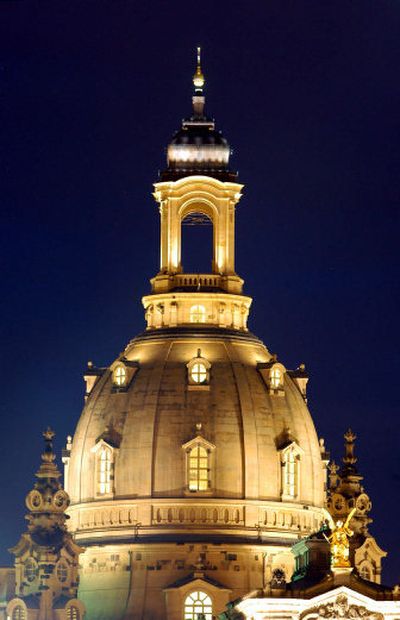Dresden’s cathedral again graces skyline

DRESDEN, Germany – For many, the restoration of Dresden’s domed 18th-century cathedral, wrecked by Allied bombs during World War II, is more than just the return of a cherished landmark: It is a testament to the strength of the human spirit, to its ability to forgive and maintain hope.
To honor that sentiment, more than 100,000 people are expected to gather today in this east German city for the dedication of the Frauenkirche, whose bell-shaped, sandstone dome, topped with a golden cross and orb, once again graces the skyline.
“This restored church stands as a symbol of peace and forgiveness,” said Eberhard Burger, the construction manager who oversaw every detail of the Baroque church’s painstaking reconstruction.
German President Horst Koehler, outgoing Chancellor Gerhard Schroeder and Chancellor-designate Angela Merkel are all expected to attend today’s service and celebration.
Of the project’s $215 million cost, roughly $120 million came from donations – including a sizable amount from the United States and Britain, whose forces destroyed many German cities in defeating the Nazis.
“Donations came from around the world: from England, France, the United States and even Japan,” Burger said. “There was a tremendous outpouring of friendship and support that allowed us to rebuild the church.”
The project was not always so popular. When a group of Dresden residents first proposed rebuilding the church to authorities in 1990, shortly after the fall of the Berlin Wall, many said it couldn’t – and shouldn’t – be done.
For 47 years, Dresden residents had known the Frauenkirche, or Church of Our Lady, as a 43-foot-high mound of rubble flanked by two jagged walls. That was all that remained after British and American planes strafed the city with firebombs on the night of Feb. 13-14, 1945.
East German authorities had left it untouched as a memorial.
Yet the project gathered momentum. As hundreds of architects, art historians and engineers sorted the thousands of stones, identifying and labeling each for reuse in the new structure, others worked to raise money.
One was Gunter Blobel, a German-born American who saw the original Frauenkirche as a boy when his family took shelter in Dresden toward the end of the war. In 1999, when Blobel won the Nobel Prize for medicine, he gave most of his nearly $1 million prize to the project. Then he returned to his New York home and raised more funds. For him, as for many others, the Frauenkirche was more than just a church. It was a place where Bach and Richard Wagner had played and composed, a fairy-tale structure of soaring spires and graceful lines.
Inside, the cathedral is bright, painted in pastel yellows, pinks and blues and trimmed with gold. Light from clear glass windows high in the dome illuminate the space below.
Part of the church’s uniqueness is its round structure, the pews fanning out from the altar in a circle like ripples from a stone thrown into water. The upper galleries also hold pews.
And while the inside smells of new wood and fresh paint, reminders of the past are everywhere.
Two thousand pieces of the original altar were cleaned and incorporated into the new structure. The church’s outer walls are mottled with original stones, blackened with time and age. Most visible, to the right of the new altar, is the cross that once topped the dome, now twisted and charred.